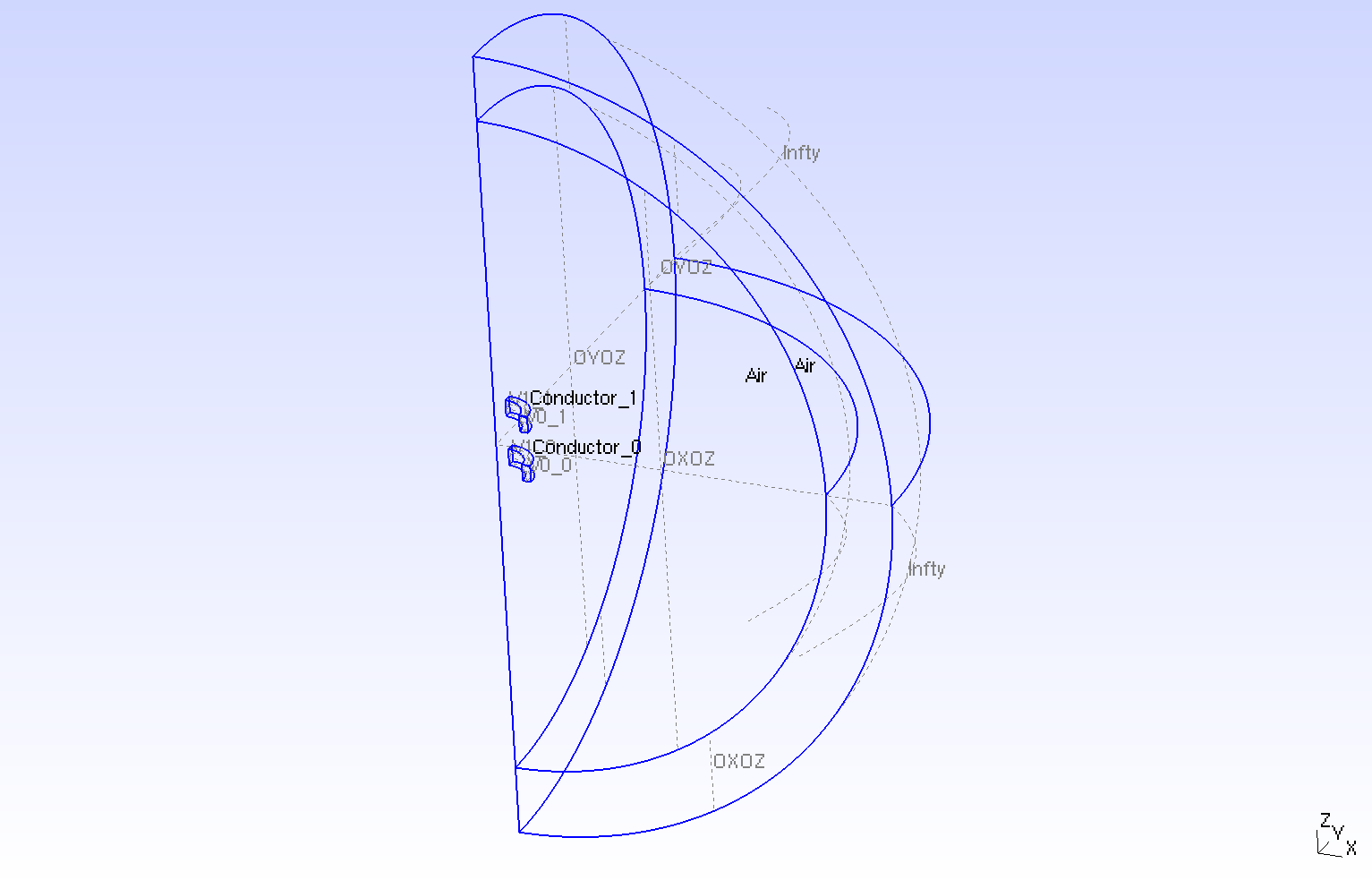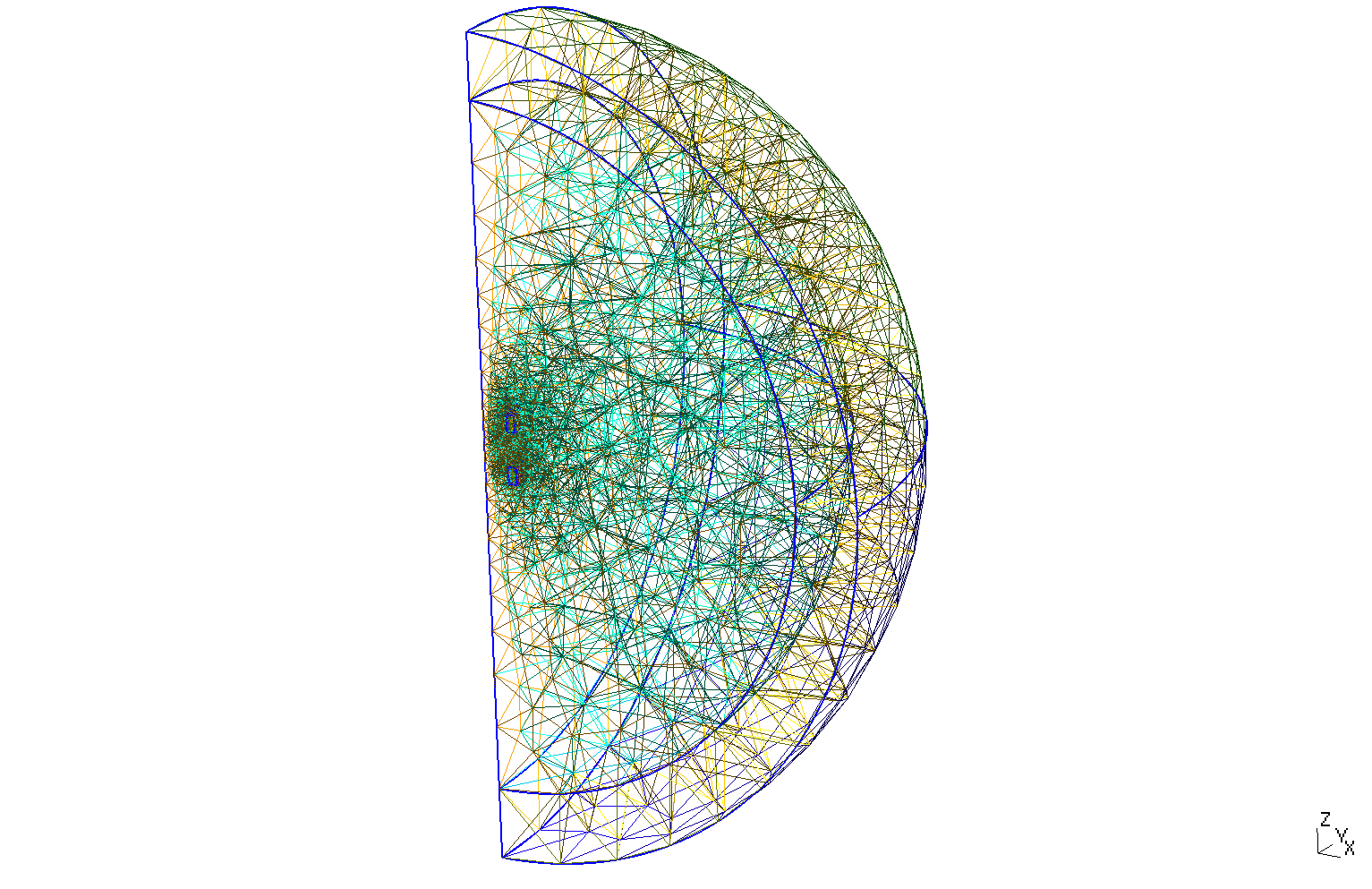Test Case of Maxwell Quasi Static with Regularized Formulation on Two Torus
1. Introduction
This is the test case of Maxwell Quasi Static Problem with the A-V Formulation and Gauge Condition on a two torus geometry surrounded by air.
2. Run the Calculation
The command line to run this case is :
feelpp_toolbox_coefficientformpdes --config-file=mqs_reg.cfg --cfpdes.gmsh.hsize=5e-3
This case is run with the latest version 109 of Feelpp.
3. Data Files
The case data files are available in Github here :
-
CFG file - Edit the file
-
JSON file - Edit the file
-
GEO file - Edit the file
4. Equation
The domain \(\Omega\) is composed of the conductor \(\Omega_c\) and non conducting materials \(\Omega/\Omega_c\) where \(\mathbf{J} = 0\), like the air for example. \(\Gamma = \partial \Omega\) is the bound of \(\Omega\), decomposed in \(\Gamma_D\) with Dirichlet boundary condition and \(\Gamma_N\) with Neumann boundary condition, such that \(\Gamma = \Gamma_D \cup \Gamma_N\).
We introduce :
-
Magnetic potential field \(\mathbf{A}\) : the magnetic field is \(\textbf{B} = \nabla \times \textbf{A}\)
-
Electric potential scalar : \(\nabla V = - \textbf{E}\)
We want to resolve the electromagnetic problem ( with \(\mathbf{A}\), \(p\) and \(V\) as the unknowns) :
With :
-
\(\sigma\) : electric conductivity \(S/m\)
-
\(\mu\) : electric permeability \(kg/A^2/S^2\)
(See A-V Regularized Formulation).
5. Geometry
The geometry is a quarter of two conducting torus, surrounded by air.

Geometry
|
.png)
Geometry loop on Conductors
|
The geometrical domains are :
-
Conductor_0: the first torus, it is composed of conductive materials-
V0_0: entrance of electrical potential -
V1_0: exit of electrical potential
-
-
Conductor_1: the second torus, it is composed of conductive materials-
V0_1: entrance of electrical potential -
V1_1: exit of electrical potential
-
-
Air(\(\Omega/\Omega_c\)) : the air surroundingConductor-
OXOZ: \(OxOz\) plan -
OYOZ: \(OyOz\) plan -
Infty: the rest ofAir's bound
-
Symbol |
Description |
value |
unit |
\(r_{int}\) |
interior radius of torus |
\(75e-3\) |
m |
\(r_{ext}\) |
exterior radius of torus |
\(100.2e-3\) |
m |
\(z_1\) |
half-height of torus |
\(25e-3\) |
m |
\(r_{infty}\) |
radius of infty border |
\(5*r_{ext}\) |
m |
6. Boundary Conditions
The Dirichlet boundary conditions imposed are :
-
For \(V\) equation :
-
On
V0_0andV0_1: \(V=0\) -
On
V1_0: \(V = \begin{cases}\frac{1}{4}\frac{t}{0.1}&\quad\text{if }t<0.1\\ \frac{1}{4}&\quad\text{if }0.1<t<0.5\\ 0&\quad\text{if }t>0.5\end{cases} \) -
On
V1_1: \(V = \begin{cases}\frac{1}{4}\frac{t}{0.1}&\quad\text{if }t<0.1\\ \frac{1}{4}&\quad\text{if }0.1<t<0.7\\ 0&\quad\text{if }t>0.7\end{cases} \)
-
-
For \(\mathbf{A}\) :
-
On
OXOZ,V0_0andV0_1: \(A_x = A_z = 0\), we want \(\mathbf{A}\) orthogonal toOXOZandV0 -
On
OYOZ,V1_0andV1_1: \(A_y = A_z = 0\), we want \(\mathbf{A}\) orthogonal toOYOZandV1 -
Infty: We approximate the problem,Inftyis the physical infty so \(\mathbf{B}=0\) atInftythus \(\mathbf{A} = 0\)
-
-
For \(p\) :
-
On
OXOZ,V0_0andV0_1: \(p = 0\) -
On
OYOZ,V1_0andV1_1: \(p = 0\) -
Infty: \(p = 0\)
-
On JSON file, the boundary conditions are written :
"BoundaryConditions":
{
"magnetic":
{
"Dirichlet":
{
"boundary":
{
"markers":["Infty"],
"expr":"{0,0,0}"
},
"mydir_x":
{
"markers":["V0_0","V0_1","OXOZ"],
"expr":"{0,0,0}"
},
"mydir_y":
{
"markers":["V1_0","V1_1","OYOZ"],
"expr":"{0,0,0}"
},
"mydir_z":
{
"markers":["V0_0","V0_1","OXOZ","V1_0","V1_1","OYOZ"],
"expr":"{0,0,0}"
}
}
},
"electric":
{
"Dirichlet":
{
"V0_0":
{
"expr":"materials_Conductor_0_V0:materials_Conductor_0_V0"
},
"V0_1":
{
"expr":"materials_Conductor_1_V0:materials_Conductor_1_V0"
},
"V1_0":
{
"expr":"materials_Conductor_0_V1:materials_Conductor_0_V1"
},
"V1_1":
{
"expr":"materials_Conductor_1_V1:materials_Conductor_1_V1"
}
}
}
},
7. Weak Formulation
8. Parameters
The parameters of the problem are :
-
On
Conductor_0:
Symbol |
Description |
Value |
Unit |
\(V0\) |
scalar electrical potential on |
\(0\) |
\(Volt\) |
\(V1\) |
scalar electrical potential on |
\(\begin{cases}\frac{1}{4}\frac{t}{0.1}&\quad\text{if }t<0.1\\ \frac{1}{4}&\quad\text{if }0.1<t<0.5\\ 0&\quad\text{if }t>0.5\end{cases}\) |
\(Volt\) |
\(\sigma\) |
electrical conductivity |
\(58e6\) |
\(S/m\) |
\(\mu=\mu_0\) |
magnetic permeability of vacuum |
\(4\pi.10^{-7}\) |
\(kg \, m / A^2 / S^2\) |
-
On
Conductor_1:
Symbol |
Description |
Value |
Unit |
\(V0\) |
scalar electrical potential on |
\(0\) |
\(Volt\) |
\(V1\) |
scalar electrical potential on |
\(\begin{cases}\frac{1}{4}\frac{t}{0.1}&\quad\text{if }t<0.1\\ \frac{1}{4}&\quad\text{if }0.1<t<0.7\\ 0&\quad\text{if }t>0.7\end{cases}\) |
\(Volt\) |
\(\sigma\) |
electrical conductivity |
\(58e6\) |
\(S/m\) |
\(\mu=\mu_0\) |
magnetic permeability of vacuum |
\(4\pi.10^{-7}\) |
\(kg \, m / A^2 / S^2\) |
-
On
Air:
Symbol |
Description |
Value |
Unit |
\(\mu=\mu_0\) |
magnetic permeability of vacuum |
\(4\pi.10^{-7}\) |
\(kg \, m / A^2 / S^2\) |
On JSON file, the parameters are written :
"Parameters":
{
"sigma":58e6,
"mu":"4*pi*1e-7"
},
"Materials":
{
"Conductor_0":
{
"V0":0,
"V1":"1/4*(t/0.1*(t<0.1)+(t<0.5)*(t>0.1)):t",
//[...]
},
"Conductor_1":
{
"V0":0,
"V1":"1/4*(t/0.1*(t<0.1)+(t<0.7)*(t>0.1)):t",
//[...]
},
"Air":
{
//[...]
}
},
9. Coefficient Form PDEs
The Feelpp toolboxe Coefficient Form PDEs is used here /*insert ref */. The coefficients associated to the Weak Formulation are :
-
On
Conductor_0andConductor_1:
Coefficient |
Description |
Expression |
|
damping or mass coefficient |
\(\sigma\) |
|
…. coefficient |
\(\frac{1}{\mu}\) |
|
source term |
\(- \sigma \nabla V \) |
|
absorption or reaction coefficient |
\(\epsilon\) |
|
damping or mass coefficient |
\(\sigma\) |
|
source term |
\(\sigma \, \frac{d \mathbf{A}}{d t}\) |
-
On
Air:
Coefficient |
Description |
Expression |
|
… coefficient |
\(\frac{1}{\mu}\) |
|
absorption or reaction coefficient |
\(\epsilon\) |
|
conservative flux source term |
\(\mathbf{A}\) |
On JSON file, the coefficients are written :
"Materials":
{
"Conductor_0":
{
"V0":0,
"V1":"1/4*(t/0.1*(t<0.1)+(t<0.5)*(t>0.1)):t",
"magnetic_d":"sigma:sigma",
"magnetic_zeta":"1/mu:mu",
"magnetic_f":"{-sigma*electric_grad_V_0,-sigma*electric_grad_V_1,-sigma*electric_grad_V_2}:sigma:electric_grad_V_0:electric_grad_V_1:electric_grad_V_2",
"magnetic_a":"epsilon:epsilon",
"electric_c":"sigma:sigma",
"electric_gamma":"{sigma*magnetic_dA_dt_0,sigma*magnetic_dA_dt_1,sigma*magnetic_dA_dt_2}:sigma:magnetic_dA_dt_0:magnetic_dA_dt_1:magnetic_dA_dt_2"
},
"Conductor_1":
{
"V0":0,
"V1":"1/4*(t/0.1*(t<0.1)+(t<0.7)*(t>0.1)):t",
"magnetic_d":"sigma:sigma",
"magnetic_zeta":"1/mu:mu",
"magnetic_f":"{-sigma*electric_grad_V_0,-sigma*electric_grad_V_1,-sigma*electric_grad_V_2}:sigma:electric_grad_V_0:electric_grad_V_1:electric_grad_V_2",
"magnetic_a":"epsilon:epsilon",
"electric_c":"sigma:sigma",
"electric_gamma":"{sigma*magnetic_dA_dt_0,sigma*magnetic_dA_dt_1,sigma*magnetic_dA_dt_2}:sigma:magnetic_dA_dt_0:magnetic_dA_dt_1:magnetic_dA_dt_2"
},
"Air":
{
"physics":"magnetic",
"magnetic_zeta":"1/mu:mu",
"magnetic_a":"epsilon:epsilon"
}
},
10. Numeric Parameters
This section show the parameters used to compute the simulation.
-
Size of mesh :
-
On
Conductor: \(0.5 \, mm\) -
On
Infty: \(100 \, mm\)
-
-
Time Parameters :
-
Time step : \(0.01 \, s\)
-
Initial Time : \(0 \, s\)
-
Final Time : \(1 \, s\)
-
-
Element type : \(P1\)
-
Solver : automatic
-
Number of CPU core : \(32\)

Mesh of Geometry
|
11. Results
12. References
-
Cecile Daversin - Catty. Reduced basis method applied to large non-linear multi-physics problems: application to high field magnets design. Electromagnetism. Université de Strasbourg, 2016. p56-64 PDF